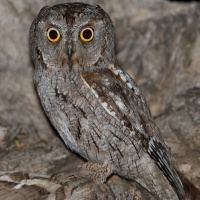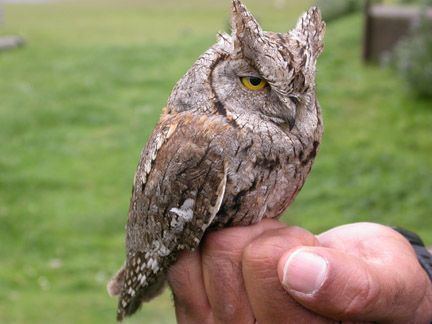Subclass Neornithes Superorder Neoaves Scientific name Otus | Infraclass Neognathae Higher classification True owl | |
 | ||
Lower classifications | ||
Indian scops owl 6 months
Scops owls are typical owls (family Strigidae) mostly belonging to the genus Otus. Approximately 45 living species are known, but new ones are frequently recognized and unknown ones are still being discovered every few years or so, especially in Indonesia. For most of the 20th century, this genus included the American screech owls, which are now again separated in Megascops based on a range of behavioral, biogeographical, morphological and DNA sequence data. Otus is the largest genus of owls in terms of number of species.
Contents
- Indian scops owl 6 months
- Cyprus scops owl otus cyprius endemic to cyprus
- Ecology and behaviour
- Taxonomy and systematics
- Evolution
- The splitting of Otus sensu lato
- Species
- Formerly placed here
- References

Scops owls in the modern sense are restricted to the Old World. A single North American species, the flammulated owl, was provisionally placed in Otus and has now been moved to its own monotypic genus. See below for details.

As usual for owls, female scops owls are usually larger than the males of their species, with owls of both sexes being compact in size and shape. All of the birds in this genus are small and agile. Scops owls are colored in various brownish hues, sometimes with a lighter underside and/or face, which helps to camouflage them against the bark of trees. Some are polymorphic, occurring in a greyish- and a reddish-brown morph.
Cyprus scops owl otus cyprius endemic to cyprus
Ecology and behaviour

Scops owls hunt from perches in semi-open landscapes. They prefer areas which contain old trees with hollows; these are home to their prey which includes insects, reptiles, small mammals such as bats and mice and other small birds. The owls will also eat earthworms, amphibians and aquatic invertebrates. Scops owls have a good sense of hearing which helps them locate their prey in any habitat. They also possess well-developed raptorial claws and a curved bill, both of which are used for tearing their prey into pieces small enough to swallow easily.

Scops owls are primarily solitary birds. Most species lay and incubate their eggs in a cavity nest that was originally made by another animal. During the incubation period, the male will feed the female. These birds are monogamous, with biparental care, and only fledge one young per year. The young of most scops owls are altricial to semialtricial.
As opposed to screech owls, scops owls have only a single type of call. This consists of a series of whistles or high-pitched hoots, given with a frequency of 4 calls per second or less, or of a single, drawn-out whistle. Calls differ widely between species in type and pitch, and in the field are often the first indication of these birds' presence, as well as the most reliable means to distinguish between species. Some, like the recently described Serendib scops owl (Otus thilohoffmanni), were discovered because their vocalizations were unfamiliar to experts in bird-calls.
Taxonomy and systematics
The genus name is from the Latin otus for an eared owl.
Due to a nomenclatorial dispute, the generic name Scops is not used by either the scops or the screech owls (which when only a few species were known were placed together), nor by any other animal. In 1760, Mathurin Jacques Brisson had established the genus Scopus for the hammerkop, a peculiar African bird. Paul Möhring in 1758 had already used the name Scops for this bird however, and believing this name to be valid Morten Thrane Brünnich replaced Scopus with it in 1772. The scops and screech owls, which were placed in Otus by Thomas Pennant in 1769 (as he too believed that Moehring's Scops was valid) were moved to Scops by Marie Jules César Savigny in 1809. Lorenz Oken in 1817 changed this to Scopus, also under the impression that Scops was the older name for the hammerkop, and valid.
However, the names established by Moehring pre-date the official start date of Linnean nomenclature in zoology as regulated by the ICZN, which is December 31, 1758 – the last day of the year in which the 10th edition of Linné's Systema Naturae was published. Hence, Scopus as established by Brisson is indeed the valid generic name of the hammerkop, and the first valid use of Scops was in 1772 by Brünnich – which according to modern rules of zoological nomenclature was unjustified however, as the name he believed to be reinstating had never been technically valid in the first place.
Evolution
The evolutionary relationships of the scops and screech owls are not entirely clear. What is certain is that they are very closely related; they may be considered sister lineages which fill essentially the same ecological niche in their allopatric ranges. A screech-owl fossil from the Late Pliocene of Kansas – which is almost identical to eastern and western screech owls – indicate a long-standing presence of these birds in the Americas, while coeval scops owl fossils very similar to the Eurasian scops-owl have been found at S'Onix on the Spanish island Majorca. The scops and screech owl lineage probably evolved at some time during the Miocene (like most other genera of typical owls), and the three (see below) modern lineages separated perhaps roughly 5 million years ago. Note that there is no reliable estimate of divergence time, as Otus and Megascops are osteologically very similar, as is to be expected from a group that has apparently conserved its ecomorphology since before its evolutionary radiation. As almost all scops and screech owls today, their common ancestor was in all probability already a small owl, with ear tufts and at least the upper tarsus ("leg") feathered.
However that may be, the hypothesis that the group evolved from Old World stock is tentatively supported by cytochrome b sequence data.
The splitting of Otus sensu lato
While late 19th-century ornithologists knew little of the variation of these cryptic birds which often live in far-off places, with every new taxon being described a few differences between the Old and New World "scops" owls became more and more prominent. Namely, the scops owls give a whistling call or a row of high-pitched hoots with less than four individual hoots per second. This call is given in social interaction or when the owl tries to scare away other animals. The screech owls on the other hand are named for their piercing trills of more than four individual notes per second. They also have a kind of song, which is a short sequence of varying calls given by the males when they try to attract females to their nests, or between members of a pair. There are a few other differences such as the screech owls almost never being brown below which is common in scops owls, but the difference in vocalizations is most striking.
By the mid-19th century, it was becoming clear that Otus encompassed more than one genus. First, in 1848, the screech owls were split off as Megascops. The white-faced owls of Africa, with their huge eyes and striking facial coloration, were separated in Ptilopsis in 1851. In 1854, the highly apomorphic white-throated screech owl of the Andes was placed in the monotypic genus Macabra. Gymnasio was established in the same year for the Puerto Rican screech owl, and the bare-legged owl (or "Cuban screech owl") was separated in Gymnoglaux the following year; the latter genus was sometimes merged with Gymnasio by subsequent authors. The Palau owl, described only in 1872 and little-known to this day, was eventually separated in Pyrroglaux by Yoshimaro Yamashina in 1938.
In the early 20th century, the lumping-together of taxa had come to be preferred. The 3rd edition of the AOU checklist in 1910 placed the screech owls back in Otus. Although this move was never unequivocally accepted, it was the dominant treatment throughout most of the 20th century. In 1988 it was attempted to resolve this by re-establishing all those genera split some 140 years earlier at subgenus rank inside Otus. Still, the diversity and distinctness of the group failed to come together in a good evolutionary and phylogenetic picture, and it was not until the availability of DNA sequence data that this could be resolved. In 1999, a preliminary study of mtDNA cytochrome b across a wide range of owls found that even the treatment as subgenera was probably unsustainable and suggested that most of the genera proposed around 1850 should be accepted. Though there was some debate about the reliability of these findings at first, they have been confirmed by subsequent studies. In 2003, the AOU formally re-accepted the genus Megascops again.
The flammulated owl has been found to be marginally closer to the screech owls than to the scops owls, but by no means robustly or reliably so. If the scops and screech owl clade indeed originated in the Old World, the flammulated owl's ancestors either colonized the Americas independently from but at about the same time and from much the same stock as the screech owls', or they diverged immediately after the latter had settled in the New World. In any case, "Otus" flammeolus now usually warrants separation in its own monotypic genus as this would best agree with the available data. It has been retained in Otus simply because it does not have the characteristic "song" or rapid trill of Megascops.
Species
An apparent Otus owl was heard calling at about 1,000 meters ASL south of the summit of Camiguin in the Philippines on May 14, 1994. No scops owls had previously known from this island, and given that new species of Otus are occasionally discovered, it may have been an undescribed taxon.
On July 23, 2016 an unknown species of Otus owl was photographed on Príncipe. The image was published on Ornithomedia.
Formerly placed here
As noted above, the fossil record of scops owls gives an incomplete picture of their evolution at present. While older sources cite many species of supposed extinct Otus (or "Scops"), these are now placed in entirely different genera:
